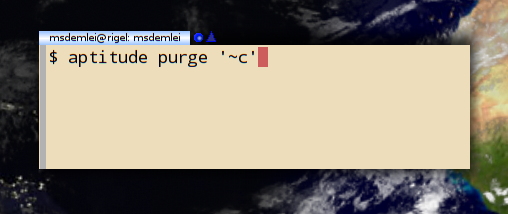A Tale of CLUSTER and Failure

This command nuked 5 TB of database tables (with a bit of folly before).
Whenever you read “backup”, the phrase “lessons learned” is usually not far off. And so it is here, with a little story for DaCHS operators (food for thought, I'd say), astronomers (knowing what's going on behind the curtain sometimes helps write better queries), and everyone else (for amusement and a generous helping of schadenfreude).
It all started yesterday when I upgraded the main database server of our data center (most anything in the VO with a org.gavo.dc in the IVOID depends on it) to Debian stretch. When that was done, I decided that with about 1000 installed packages, too much cruft had accumulated and started happily removing unused software. Until I accidentally removed the postgres package. In itself, that would not have been so disastrous – we're running Debian, which means packages usually keep the configuration and, in particular, the data around even if you remove them. The postgres packages, at the very least, do, and so does DaCHS.
Unless, that is, you purge the postgres package before you notice you've removed it. I, for one, found it appropriate to purge all packages deleted but not purged right after my package deletion spree. Oh bother. Can you imagine my horror when the beastly machine said “dropping cluster main”? And ignored my panic-induced ^C (which, of course, was the right thing to do; the database was toast already anyway).
There I had just flushed 5 Terabytes of highly structured data down the drain.
Well, go restore from backup, you say? As usual with backups, it's not that simple™. You see, backing up databases is tricky. One can of course just back up the files as they are and then try to restore from them. However, while the database is running, it is continually modifying what's on the disk, so such a backup will be an inconsistent, unusable mess. Even if one had a file system that can do snapshots, a running server has in-memory state that is typically needed to make heads and tails of the disk image.
So, to back up a database, there are essentially variations of two themes, roughly:
- ask the database to dump itself. The result is a conventional file that essentially is a recipe for how to re-create a particular state of the database.
- have a “hot spare”. That's another machine with a database server running. In one way or another that other box snoops on what the main machine is doing and just replicates the actions it sees. The net effect is that you have an immediately usable copy of your database server.
Anyway, after the opening of this article you'll not be surprised to learn that we did neither. The hot spare scenario needs a machine powerful enough to usefully serve as a stand-in and to not slow down the main machine when we feed data by the Gigarecords. Running such a machine just for backup would be a major waste of electricity – after all, this is the first time in about 10 years that it would really have been needed, and such a box slurps juice like it's... well, juice.
As to maintaining a dump: Well, for the big catalogs, we use DaCHS' direct grammars [PSA: don't follow this link unless you're running DaCHS]. These are, except perhaps for a small factor, just as fast as a restore from a dump. And the indices (i.e., data structures that tell the computer where to look for objects with a certain position or magnitude rather than having to go through the whole table) need to be re-made when restoring from dumps, too, so we'd be pushing around files of several terabyte for almost no benefit.
Except. Except I could have known better, because during catalog ingestions the most time-consuming task usually is the CLUSTER operation. That's when the machine re-organises the data on disk so it matches expected access patterns – for astronomical data, that's usually by spatial location. Having a large table clustered makes an astonishing difference, in particular when you're still using spinning disks (as we are). So, there's really no way around it.
But it takes time. And more time. And that time is saved when restoring from a dump, because the dump (hopefully) largely preserves the on-disk organisation, and so the CLUSTER is almost a no-op.
Well, the bottom line is: on our Heidelberg data center, the big tables are only coming back slowly; as I write this, from the gigarecord league PPMXL and GPS1 are back, with SDSS DR7 and HSOY expected later today. But it'll probably take until late next week until all the big tables are back in and properly indexed and clustered.
Apologies for any inconvenience. On the other hand, as measured by our regression tests (DaCHS operators: required reading!) 90% of our stuff is fine again, so we could fare worse given we just had a database disaster of magnitude 5 on the Terabyte scale.
Which begs the question: Was it better this way? At least many important services are safely back up, and that might very well not be the case were we running the restore from an actual dump. Hm.

![[RSS]](../theme/image/rss.png)